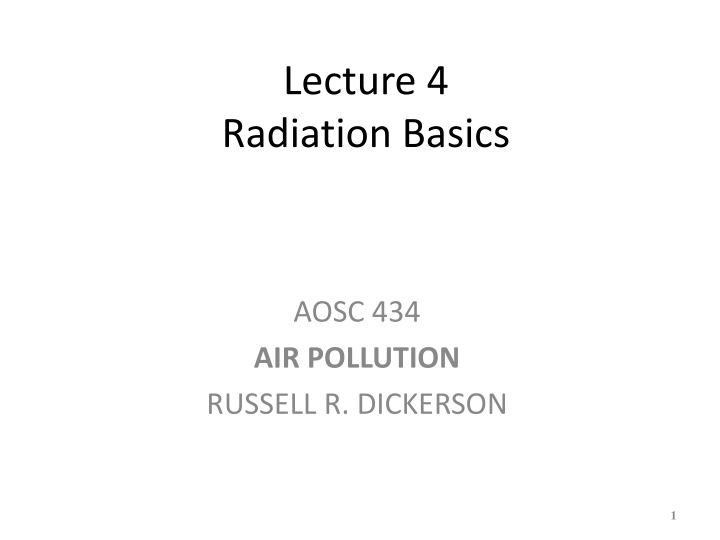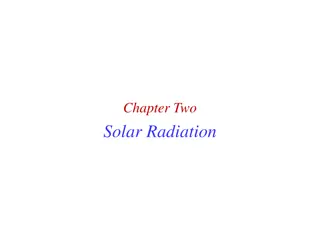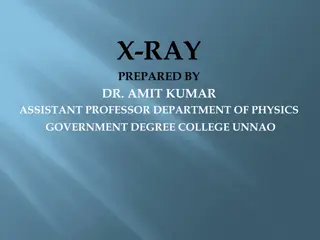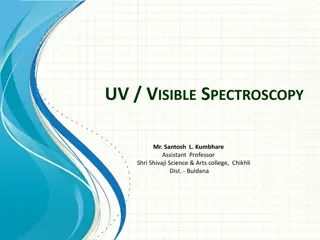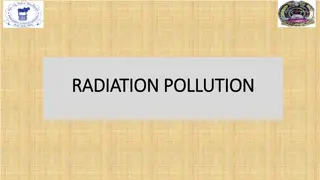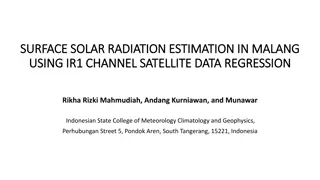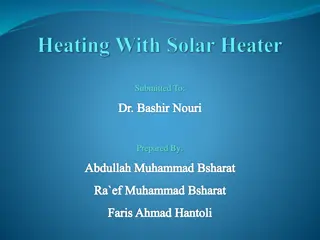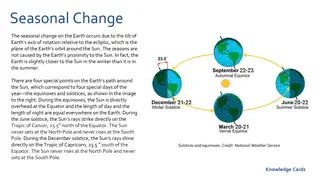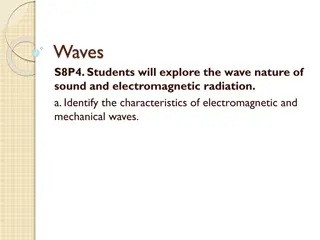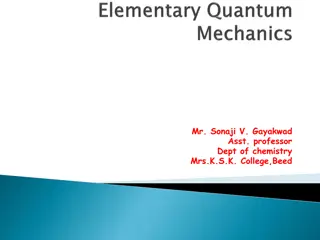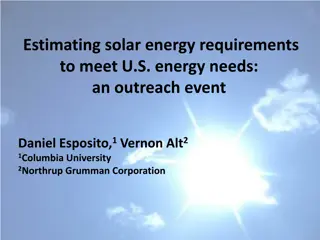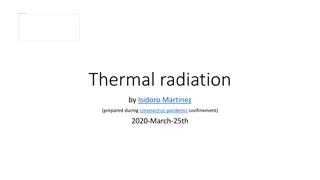Electromagnetic Radiation and Solar Energy Interactions
The interaction between electromagnetic radiation and the Earth's atmosphere is crucial for powering atmospheric processes and sustaining life on our planet. From the Sun's energy production to the absorption patterns of different gases in the atmosphere, various laws like Planck's Law, Stefan-Boltzmann Law, and Wien's Law dictate these interactions. Understanding these principles helps us comprehend the distribution of solar radiation, the impact of atmospheric composition on energy absorption, and the seasonal variations driven by Earth's tilt.
Download Presentation

Please find below an Image/Link to download the presentation.
The content on the website is provided AS IS for your information and personal use only. It may not be sold, licensed, or shared on other websites without obtaining consent from the author.If you encounter any issues during the download, it is possible that the publisher has removed the file from their server.
You are allowed to download the files provided on this website for personal or commercial use, subject to the condition that they are used lawfully. All files are the property of their respective owners.
The content on the website is provided AS IS for your information and personal use only. It may not be sold, licensed, or shared on other websites without obtaining consent from the author.
E N D
Presentation Transcript
Lecture 4 Radiation Basics AOSC 434 AIR POLLUTION RUSSELL R. DICKERSON 1
ELECTROMAGNETIC RADIATION The sun produces essentially all the energy the Earth receives. It powers atmospheric chemistry and drives the circulation of the atmosphere and oceans. Energy decreases with wavelength and most chemical bonds can be broken only by uv radiation. Planck s Law E = hv Sun emits over most of spectrum. Black body radiation Stefan-Boltzmann Law. E = T Wien s Displacement Law. max= a/T 2
The temperature of the Sun s photosphere is 6000 K, therefore the is 483 nm, (blue, towards green). Only a fraction of the total solar radiation reaches the Earth s surface. The atmosphere controls the amount reaching surface. The Earth, at 250 K, has a of 9.6 m or 9600 nm, in the IR. (1400 Wm reach outside of our atmosphere). E emitted energy Total ET= max max = 7 2 7.35 = 10 Wm sun 3 2 E 4.6 10 Wm earth E = Energy of a photon h = Planck s constant v = Frequency c = Speed of light Stephan = = Boltzman Constant Wavelength a = Wien s constant 6
Plancks Law for blackbody radiation: 2 2 1 kT hc = 2 - 1 - ( , ) ( Wm m ) E T 5 / hc 1 e Take first derivative wrt T and set to zero: Wien s Law: 3 -1 9 . 2 10 m K a = = ( m) max T T Integrate over all wavelength: Stephan-Boltzmann Law: ET=sT4(W/m2) 7
Plancks Law says that the energy of a photon is proportional to its frequency. h E = ) J ( Where Planck s Const., h = 6.6x10-34 Js The energy associated with a mole of photons at a given wavelength in nm is: = 5 2 . 1 10 x / ( /mole kJ ) E 8
Summary: the Stephan Boltzmann Law and Wiens Law are a consequence of Planck s function: 2 2 hc hc = ( ) B T ( ) 1 5 / K T e Differentiate wrt and find maximum to get Wien s Law. Integrate wrt to find Stephan Boltzmann Law. Atmospheric O and O absorbs most of UV. H O & CO absorbs most of IR. Small fraction of atmospheric gases do most of the absorbing. Visible window IR window between 8 to 10 m (note ozone) Ozone sets solar intensity in UV at the Earth s surface Seasons are caused by the tilt of the Earth. The angle of incidence (not the distance for the sun) controls the amount of radiation reaching a given area. 9
Sun The sun appears more nearly overhead in summer than in winter. EARTH ( ) I = cos 0 I Sun Zenith SURFACE 10
The amount of radiation available for the production of photochemical smog also depends on the angle of incidence there is more smog in the LA summer than winter; Washington and Baltimore violate the ambient air quality standard for ozone in the summer, but not the winter. BEER S LAW I/I = ( ) cl e 0 If we define absorption as follows: = = ln( / ) ( ) abs I I cl 0 Then a doubling of the concentration or a doubling of the path length will double the absorption. 11
Near zero this is linear; for example, if the absorption, cl, is 10 then I/I = 0.999. 0 I/I = ln( I abs = ( ) cl e / = ) ( ) I cl 0 Consider the impact of the solar zenith angle on path length: Sun Zenith ( ) = / exp / cos I I cl 0 cos cl = abs ( ) 12
Thermodynamics and Radiation First Law of Thermodynamics: Energy is heat plus work. U = Q - W dU = Q - W 1 The internal energy, U, in Eq. 1 is an Equation of State, that is dependent only on the initial and final states or path independent. Remember that Equations of State are exact differentials indicated with a d . Chemical reactions involved in air pollutions occur at constant pressure, thus it is important to know if the heat exchanged in these reactions is path independent. Enthalpy, Bond Energy, and Entropy Enthalpy is defined as: H = U + PV 13
Absolute values of enthalpy do not exists, thus we talk of changes in enthalpy. H = U + (PV) dH = dU + VdP + PdV Note that when the only work done is PdV work and when the pressure is constant (dP = 0) enthalpy is identical to heat. dU = DQ + PdV + VdP dH = DQ + PdV = VdP - VdP + PdV dHP=DQP Enthalpy, or heat, of formation is given the symbol Hf and is the heat released or absorbed in the formation of a substance from its elements. A superscript o indicates standard conditions. Not that standard temperature for thermodynamic properties is 25 0C not 0 0C. (SEE TABLE; also back of Pitts book.) Chemical and physical systems then toward the lowest enthalpy. 14
Elements in their most stable state at RTP (e.g. O, N, H, Cgraph) are defined as having Hf of zero. The change of heat in reaction is the sum of the heats of formation of the products minus the sum of the heats of formation of the products. products Hf rxn H = 0 0 0 reactants Hf In general combustion is the process of oxidation to CO and H O. The combustion of coal (C) to CO is the same as the heat of formation of CO because the reactants are elements in their most stable state. C + O CO Consider the combustion of isooctane (C H ) which is an approximation of gasoline. Note that the ratio of N to O in air is 3.76. C H + 12.5 O (+47N ) 8CO + 9H O (+47N ) 16
We can by the way calculate the amount of air needed to cause complete combustion, and from it the air-fuel-ratio (AFR). 12.5*32 g/mole + 47*28 g/mole = 1716 g air 12*8 + 18 = 114 g fuel 1716/114 = 15 g air/ g fuel AFR = 15:1 If we assume complete combustion, then CO and H O will be the only products. = + 51) = 1243 5200kJ/mol 0 8 94 9 58 ( kcal/mole ( e) Hf rxn LOTS OF HEAT! The amount of heat from 114 g of gasoline is sufficient to boil 15 L of water if none of the heat escapes. 17
